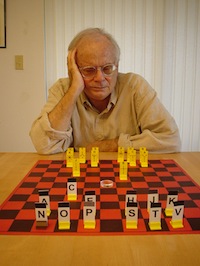Robert Abbott (game designer)
| Robert Abbott | |
|---|---|

Robert Abbott, working on his game Confusion
|
|
| Born |
March 2, 1933 St. Louis, Missouri |
| Occupation | Computer programmer |
| Known for | Inventing Logic mazes and creation of several games |
Robert Abbott (born March 2, 1933) is an American game inventor, sometimes referred to by fans as "The Official Grand Old Man of Card Games". Though early in his life he worked as a computer programmer with the IBM 360 assembly language, he has been designing games since the 1950s.
Two of his more popular creations include the chess variant Baroque chess (also known as Ultima) and Crossings, which later became Epaminondas. Eleusis was also successful, appearing in several card game collections, such as Hoyle's Rules of Games and New Rules for Classic Games, among others. In 1963, Abbott himself released a publication, Abbott's New Card Games, which included instructions for all of his card games, in addition to Baroque chess. Abbott also invented logic mazes, the first of which appeared in Martin Gardner's Mathematical Games column in the October 1962 issue of Scientific American. One of the more prominent of these is Theseus and the Minotaur, which was originally published in the book Mad Mazes. His game Confusion was named "Best New Abstract Strategy Game" for 2012 by GAMES Magazine.
Abbott was born in St. Louis, Missouri, and attended St. Louis Country Day School. Abbott went to Yale for two years, then attended the University of Colorado for another two, but never graduated. Soon after, Abbott moved to New York, where he and his games were discovered by Martin Gardner. In 1963, after Abbott's book, Abbott's New Card Games, received only moderate success, he "got tired of being poor" and moved back to St. Louis. There, he became a computer programmer at the Washington University Computer Research Laboratory. In 1965, he moved back to New York, where he continued to work as a computer programmer, mostly with the IBM 360 assembly language.
...
Wikipedia
